Camden Property Trust (NYSE:CPT) is in focus today. The REIT sustained a year-over-year drawdown of approximately 25%; however, as conveyed by the diagram below, most Seeking Alpha and Wall Street analysts are upbeat about its prospects. It is, therefore, an interesting discussion to partake in, given that most think an inflection point has been reached.
Seeking Alpha
Although most analysts are bullish on the Camden Property Trust’s prospects, we share a different view as the status of the vehicle’s salient features suggests further trouble is en route.
Without further delay, let’s head into the main analysis.
Operational Overview
For those unaware, Camden Property Trust operates a vertically integrated real estate model that sees it acquire higher-end residential units, manage them, and re-sell them after value has been added.
Although Camden’s business model has been largely successful in past years, a few stumbling blocks have occurred that might derail its market price even further in the latter stages of 2023 and throughout 2024.
Slower Rents Forecasted
The following diagram illustrates the volatility embedded in Camden Property Trust’s same property rental growth. Moreover, it is evident that a slowdown in growth has occurred ever since the start of the year.
Data Until Q2 2023) (Author’s Work, Data from GuruFocus)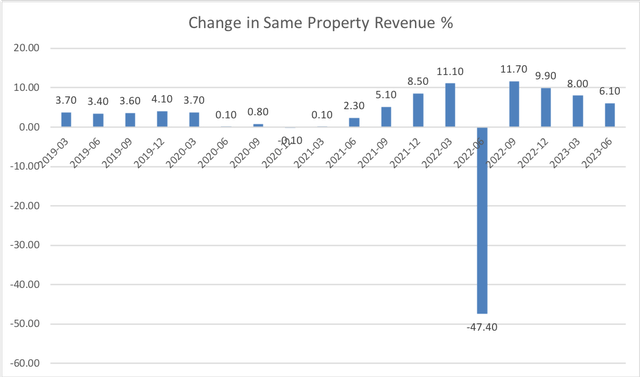
The REIT released its third-quarter results a few days ago, adding to the slowing growth echoed by the diagram as its same property revenue growth rate slipped to 6% from 6.10% in Q2. On top of that, Camden Property Trust’s management downgraded its full-year outlook, stating the following.
Recent trends in September and October reflect stronger seasonality than we have experienced over the past few years. We are adjusting our full-year 2023 outlook for higher delinquencies, and slightly lower occupancy and rent growth for the remainder of the year.
Our view aligns with management’s outlook as we believe disinflation paired with sub-factors such as growing strain on household balance sheets and fading consumer sentiment may add pressure to rent escalation capacity, therefore diminishing the scalability for REITs such as the Camden Property Trust.
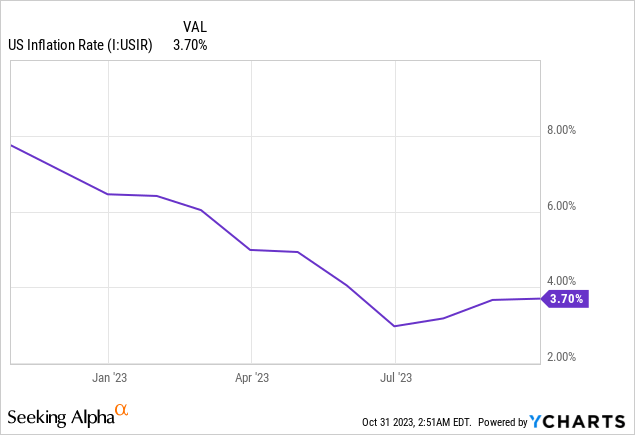
Sure, the REIT’s occupancy is robust, and we do not think it will have an issue sustaining its current revenue base. However, interim growth is the issue here, as market participants will likely criticize flat escalations.
Camden Property Trust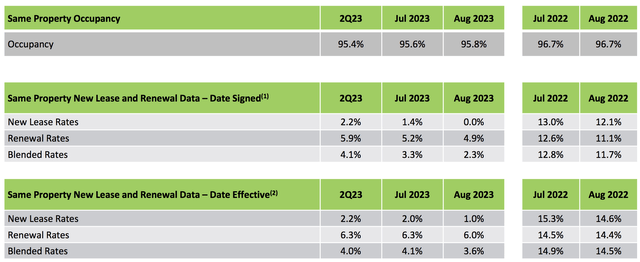
Dispositions & Acquisition Strategy – Bad Timing
Since 2011, Camden Property Trust has engaged in renewing its portfolio by using proceeds from dispositions to invest in future growth prospects via developments and new/newer build acquisitions.
The diagram below illustrates the REIT’s transformation since 2011. A more pronounced statistic is the fact that Camden Property Trust invested $2.9 billion in developments since 2011, which now have a market value of $4.2 billion. Therefore equalling $1.3 billion in value creation.
Moreover, the fund has either disposed of or redeveloped most of its 15-20-year-old units, adding much-needed value to its portfolio. As such, one can argue that the REIT’s strategy has been largely successful.
Camden Property Trust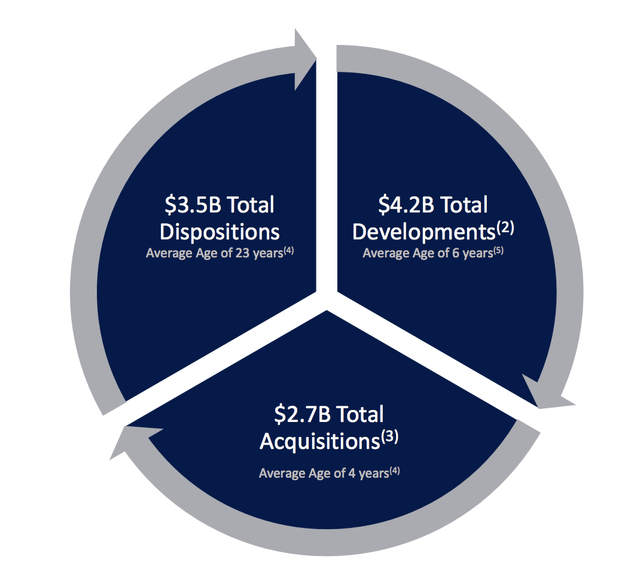
However, a few obstacles exist.
Firstly, dispositions may be unappealing in the year ahead as the real estate market’s buying power is softening amid an unfavorable interest rate environment coupled with economic tapering. Therefore, Camden’s strategy of financing new projects with dispositions is in question.
Furthermore, additional capital raises for acquisitions are challenging as equity capital is scarce, while elevated interest rates mean excessive leveraging is a no-go.
In essence, I, for one, would not be surprised to see Property Trust pause its CapEx roadmap and hang onto some deadwood until a more favorable seller’s market emerges. Subsequently delaying the REIT’s growth prospects.
Capital Structure
Let us start with a few positives here.
Camden Property Trust’s capital structure is loaded with equity, which is one of the primary reasons why its debt has strong credit ratings from leading agencies. The long-dated maturity of the debt (most of its debt matures around 2030) and non-recourse nature also contribute; however, we think the equity load plays a substantial part.
Camden Property Trust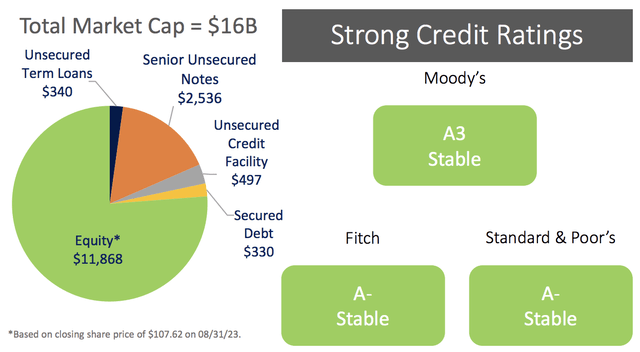
Unfortunately, Camden Property Trust has a lot of variable-rate debt. To detail, 22.6% of its debt is at variable rates, and we believe investors will start pricing interest rate uncertainty in due course, especially as counterparty risk could become a serious risk on a market-wide basis.
The aforementioned factors have certainly relayed into Camden’s equity risk premium as its CAPM is at a cyclical high. Therefore, we are aligned with the belief that its debt and equity investors are pricing a higher risk premium, leading to an argument that its market price is facing headwinds from a capital structure risk perspective.
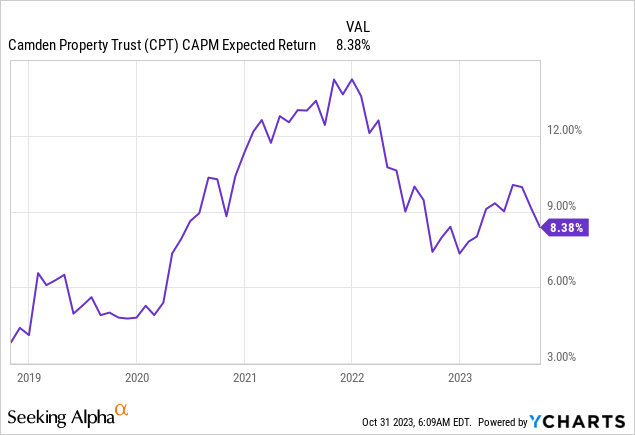
Labor Liability
The final operational matter I’d like to address today is Camden Property Trust’s substantial labor force, which tallies above 1600 individuals. Recall that the REIT is vertically integrated, whereby property management serves as a key component of the business.
At face value, this REIT has a more substantial fixed labor force than acquisition-only REIT, which could lead it to a comparable disadvantage if the economy continues to contract.
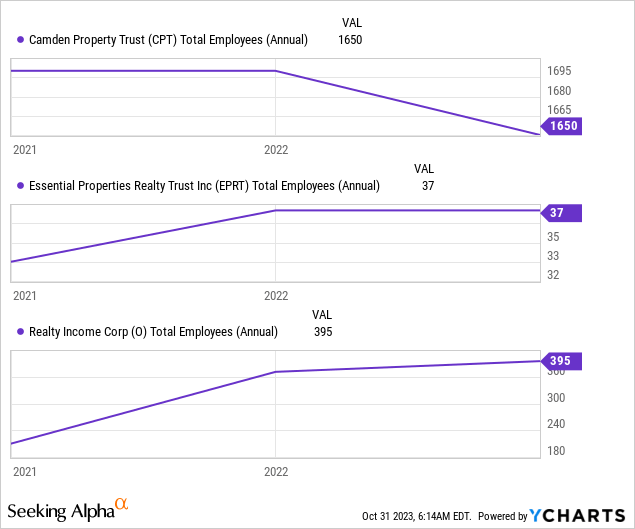
Valuation Issues
We utilized two valuation methods, and both suggest the REIT is overvalued. Although they aren’t settled law, the valuation metrics we used are widely applied across the investment industry, therefore providing strong arguments.
GGM Valuation
Firstly, an adjusted Gordon’s Growth Model suggests Camden Property Trust is overvalued by approximately 60% (at the time of writing this article). Although its forward dividend yield of 4.77% stands tall, it doesn’t quite phase out Camden Property Trust’s valuation risk.
Author’s Work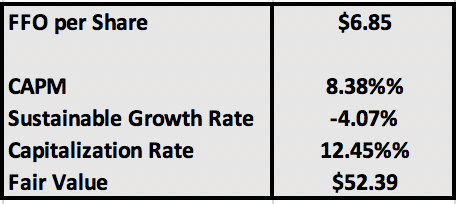
Herewith are the inputs used for the model.
- The FFO was drawn directly from the REIT’s latest managerial guidance.
- A capitalization rate was computed by adding the CAPM and the sustainable growth rate.
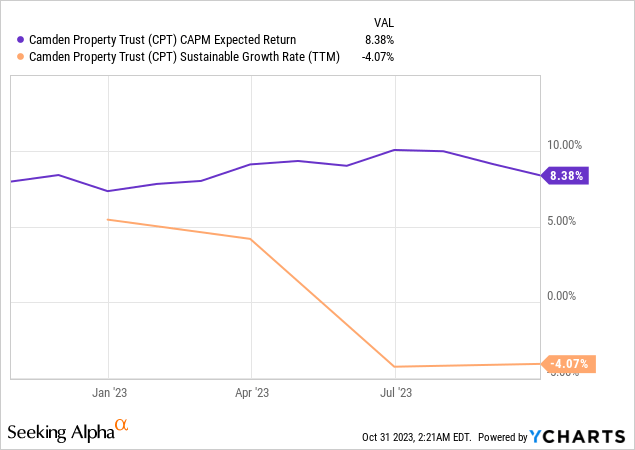
Forward Multiple Valuation
The second valuation method utilized was an adjusted P/E expansion model, which replaced the model’s EPS with FFO. The model indicates that Camden Property Trust is overvalued by approximately 15.16% (at the time of writing), again potentially phasing out the benefits of its lucrative dividend yield.
| Variable | Value |
| Sector Median FFO | 6.85$ |
| CPT’s Year-End FFO Estimate | 10.64x |
| Fair Value | $72.88 |
Source: Author’s Calculations; Data From Seeking Alpha & Camden Property Trust
A Few Contra Points
Although I mentioned a few positives within the article, I wanted to partition a separate section to communicate a few variables that contradict our bearish thesis.
Firstly, Camden Property Trust is trading below its short and long-term moving averages. One could argue that mean-reversion will eventually play a role and that Camden’s current price level provides a solid entry point. On top of that, Camden’s severe drawdown provides dividend investors with an opportunity to enter at a price that could maximize long-term dividend yield on cost.
Seeking Alpha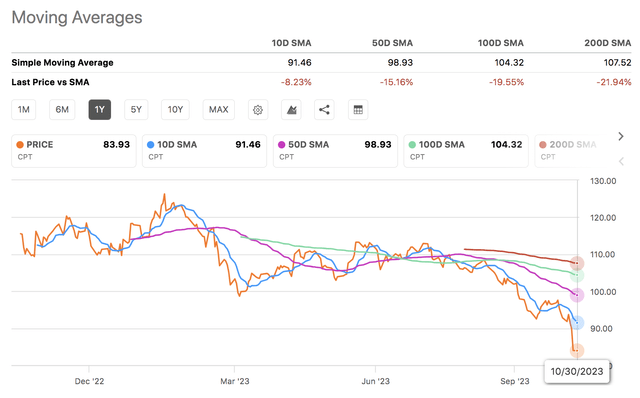
Furthermore, and as mentioned before, Camden Property Trust has a best-in-class debt rating. In fact, it is rare to see a REIT have A-rated debt as it is typically a cyclical vehicle with a tremendous amount of credit risk. The vehicle’s highly-rated debt echoes the robustness of its underlying business, which credit rating agencies clearly believe holds little default risk.
Lastly, Camden Property Trust’s CapEx roadmap provides promising signs if sustained. The REIT has clearly added significant value via developments, and such realized value indicates that continued value can be added by leveraging the same model.
Final
Despite possessing a few strengths, key metrics suggest Camden Property Trust is in a tizzy.
Various valuation models show the REIT is overvalued. Moreover, a fundamental analysis shows that slowing rental escalation is en route, while a delayed CapEx roadmap isn’t out of the question.
As such, we decided to assume a contrarian stance and assign a sell rating to Camden Property Trust.
Read the full article here



